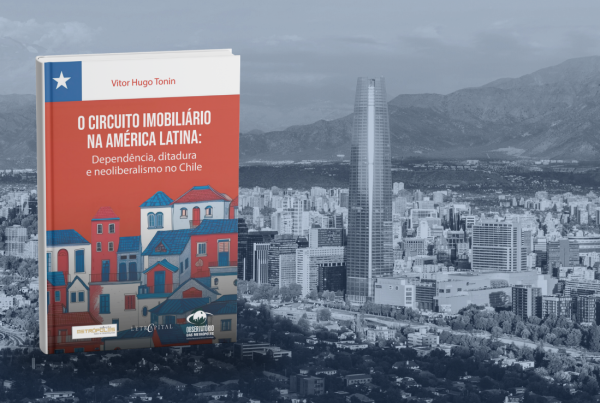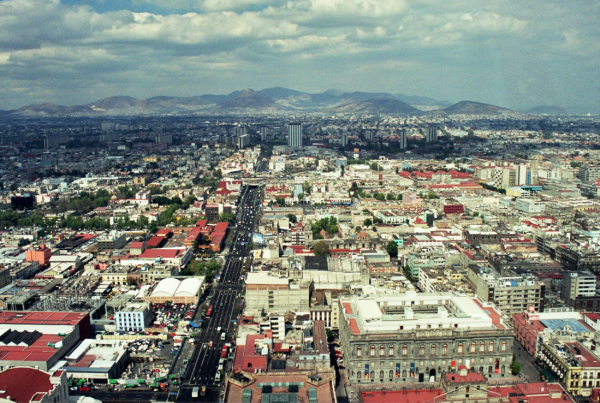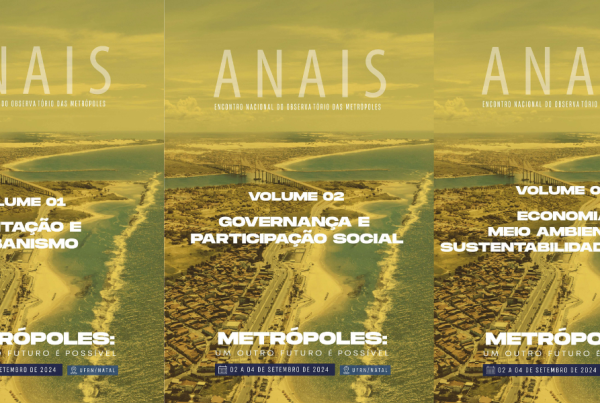
Depois de um longo ciclo de 25 anos de decadência econômica e urbana, o Rio de Janeiro finalmente pôde iniciar, em 2005, um ciclo de regeneração capitaneado pelas vitórias do Brasil em sediar a Copa 2014 e as Olimpíadas 2016. Esse contexto gerou o “milagre carioca” do qual emergiu uma coalisão urbana envolvendo os diferentes níveis de governo e os tradicionais e novos atores da economia da cidade. Todos praticando um novo modelo de governança empreendedora a fim de transformar o Rio em uma global city. Esse projeto, porém, se realiza à sombra de uma periferia metropolitana, composta por 19 cidades que concentram outros esquecidos 5,5 milhões de habitantes. É diante desse contexto que o INCT Observatório das Metrópoles lança “The Metropolis of Rio de Janeiro: a space in transition” – coletânea de artigos em língua inglesa destinada a difundir para a comunidade internacional as transformações urbanas recentes no Rio de Janeiro.
O lançamento do e-book “The Metropolis of Rio de Janeiro: a space in transition” faz parte do projeto de difusão internacional que vem sendo implementado pelo INCT Observatório das Metrópoles, de acordo com as recomendações do Conselho Nacional de Desenvolvimento Científico e Tecnológico (CNPq) e da Fundação Carlos Chagas de Amparo à Pesquisa do Estado do Rio de Janeiro (FAPERJ).
De acordo com o presidente da FAPERJ, Ruy Garcia Marques, que escreve a Apresentação do livro, o Observatório das Metrópoles direciona agora seus esforços para a difusão internacional da realidade metropolitana brasileira. “No caso desta coletânea de artigos em inglês o objeto de investigação é a formação do Rio de Janeiro enquanto cidade-metrópole. Do seu ciclo de decadência e crise iniciado no final dos anos 1970 e aprofundado na década de 1980, ao período de recuperação a partir da segunda metade dos anos 2000 com o chamado ‘milagre carioca’, passando por temas como a evolução das populações de favelas, moradia, mercado de trabalho, desigualdades urbanas, até abordar o processo de mercantilização da cidade no contexto dos megaeventos esportivos”, afirma Ruy Garcia Marques e completa:
“O Brasil não é só urbano, é também um país cada vez mais metropolitano. Monitorar as tendências de reconfiguração destes grandes aglomerados urbanos, compreender o seu papel na articulação territorial nas escalas global, nacional e regional, bem como as diferenças existentes entre eles tem sido a contribuição que o INCT Observatório das Metrópoles tem dado ao país nos últimos anos”.
Segundo o coordenador nacional do Observatório, Luiz Cesar de Queiroz Ribeiro, o livro apresenta o estado da arte das questões centrais que marcam a formação do Rio de Janeiro enquanto cidade-metrópole. “Trata-se de uma coletânea especial com dezessete artigos, já publicados, representativos da produção do Observatório, cujo foco é a dinâmica da urbe carioca. Pretende-se apresentar para o público estrangeiro algumas das reflexões sobre a questão metropolitana brasileira, e, mais especificamente, sobre o espaço urbano do Rio de Janeiro, desenvolvidas pela Rede, sob vieses teórico-metodológicos diversos. A variedade de temas e assuntos tratados reflete a capacidade multidisciplinar de uma equipe que pensa e percebe o urbano de forma plural e complementar, e, que busca a consolidação de um arcabouço teórico-conceitual próprio condizente com a realidade do país”, explica Ribeiro.
Faça no link a seguir o download do e-book “The Metropolis of Rio de Janeiro: a space in transition”.
Para leitura no computador, utilize:
– Adobe Digital Editions (para o sistema Windonws)
– Programas Calibre e Azardi (para o sistema Linux)
– EPUBReader (para Firefox)
– Plugin Readium (para o Crome)
Para Tablet:
– Programas Aldiko, Ibis Reader e FBReader (para o sistema Android)
– Programas iBooks, Bluefire Reader e Stanza (para o sistema IOS).
Acesse o link para download do livro em formato PDF.
A seguir a Apresentação do ebook, escrita por Ruy Garcia Marques presidente da FAPERJ; e uma parte do texto de introdução “Rio de Janeiro: transition and permanence”, de Luiz Cesar Ribeiro.
Presentation
BRAZIL IS NOT ONLY URBAN, it is also an increasingly metropolitan country. Today, the Brazilian urban network comprises 13 cities with over one million inhabitants, megacities (São Paulo and Rio de Janeiro), 52 metropolitan areas and 9 urban-regional agglomerations. Monitoring trends of reconfiguration of urban agglomerates, understanding their role in the territorial coordination on global, national and regional scales, as well as the differences between them, has been the contribution that the INCT Observatório das Metrópoles has given to the country in recent years.
The institute, originated in the 1990s, when analyzing the transformations of the needs and social inequalities in the Metropolitan Region of Rio de Janeiro (RMRJ), joined the Millennium Institutes Program (CNPq) in 2005 and the group of the National Institutes of Science and Technology (INCT) in 2009, under the coordination of the Ministry of Science, Technology and Innovation (MCTI) and the National Council for Scientific and Technological Development (CNPq) in partnership with the Carlos Chagas Filho Research Support Foundation of Rio de Janeiro State (FAPERJ). Over the past five years – 2009-2013 – the National Network INCT Observatório das Metrópoles has been recognized as an innovative scientific experiment by conducting research in a collaborative and creative way, overcoming not only inter- and intra-universities and disciplinary borders, but also borders of sectorial and regional policies, and producing expertise in different fronts, especially in the development of methodologies and tools for the research of the metropolitan question.
The innovations of the INCT Observatório das Metrópoles are expressed in various formats, such as the search for new models of public policies, the provision of strategic data for the intervention of various societal actors – governmental, third sector, private sector, and civil society in general – related to the metropolitan theme, as well as the set of outreach activities aimed at strengthening their capacity to intervene in a number of arenas and forums.
Now, with this release – The Metropolis of Rio de Janeiro: a space in transition – the institute directs its efforts at the international dissemination of the Brazilian metropolitan reality. In the case of this selection of articles in English, the object of investigation is the formation of Rio de Janeiro as a city-metropolis. From its cycle of decay and crisis, started in the late 1970s and deepened in the 1980s, to the period of recovery from the second half of the 2000s with the so-called “Carioca miracle”, through several topics such as the evolution of slum populations, housing, labor market, urban inequality, until approaching the process of commodification of the city in the context of the mega sporting events.
In this moment that the city of Rio de Janeiro is about to celebrate the 450 years of its foundation, I congratulate all the researchers of the INCT Observatório das Metrópoles, coordinated by Professor Luiz Cesar de Queiroz Ribeiro, for the beautiful and timely work being made available.
Ruy Garcia Marques
President of the Carlos Chagas Filho Research Support Foundation of Rio de Janeiro State – FAPERJ
Rio de Janeiro: transition and permanence
Luiz Cesar de Queiroz Ribeiro
The city of Rio de Janeiro experiences an important moment of transformation and departs from the period of the long crisis which started in the late 1970s and worsened in the early 1980s. The city was then living the impacts of the cycle of the national economic crisis in the form of a spiral of unemployment, labor informalization, poverty,

growth of favelas, urban decay and violence. The test of neo-liberal policies in the 1990s maintained and intensified in many aspects the framework of this crisis in the city. The evidence of its decline can be synthesized in a few figures: between 1989 and 1997, 22% of industrial companies moved to other regions in the country; in 1970, out of the 50 largest Brazilian banks nine had headquarters in the city, but in 1991 there were only five; Rio de Janeiro Stock Exchange, the oldest in Brazil, moved to São Paulo, joining BOVESPA; in the 1980s and 1990s, the population living in favelas grew at rates of 2.6% and 2.5% per year, while the population living in the city grew just 1.8% and 0.6% per year. It was, therefore, a long cycle of nearly 25 years of a spiral of economic and urban decay, in addition to the corrosion of the social fabric of the city. Fear and uncertainty have become remarkable features of its everyday life.
The representation of the “Marvelous City” almost disappears as metonymy of the collective pride of its inhabitants. In this period, Rio de Janeiro becomes a trend in the academic world emerging as an exemplary specimen of a gigantic inner city of 6 million inhabitants. A sort of “Cariocan miracle” has been going on from the second half of the 2000s. Since 2005, indeed, a spectacular cycle of urban regeneration governed by the following four factors has been taking place: (i) the victories of Brazil to host the 2014 Football World Cup and the 2016 Olympics Games, (ii) the return of the national economic growth under the impact of the China effect on dynamizing the international market, (iii) the resumption of the State catalyst role, and (iv) the consequent expansion of public spending. The scenario in the city changes and an urban coalition comes into view whose aim is a regeneration project for the city.
This urban coalition involves different levels of governments – till then in positions of permanent conflict – and the traditional and new actors in the economy of the city and it puts into practice a new model of entrepreneurial governance and designs a strategy for the transformation of the inner city into a global city, aiming its insertion into the international division of consumption and its transformation into an attractive business locale. From a symbol of the structural question regarding the development of Brazilian capitalism and its crisis, the City transforms itself into the image of a Brazil in takes-off and it starts experiencing a cycle of economic expansion that combines growth with employment formalization, actual increase in income from work, decrease in inequality and poverty. Large public works trigger the expansion and upgrading of urban infrastructure with the construction of new subway lines, new forms of urban mobility (BRT, LRV) and the renovation of the road system. Central areas previously degraded due to a long neglect by the public power are objects of extensive urban renewal projects. It is a time for the regeneration of self-esteem, business, quality of life and the City seems to resume its historical vocation of the “Marvelous City.” The “Cariocan miracle” puts Rio de Janeiro back in the current academic fashion, praising its success as a successful experiment of a model of entrepreneurial governance and urban policies driven by goals such as the promotion of quality of life as a force of attraction for the business city.
However, such success takes place in the shadow of a huge inner city conformed by the metropolitan periphery of Rio de Janeiro, comprising 19 cities that concentrate other forgotten 5.5 million inhabitants. Rio de Janeiro is in fact a city-metropolis, containing a densely urban territory that is strongly unified by economic and social relations, cut by municipal borders inherited from the Brazilian federative organization which no longer express the commotion of the city. Among the 12 metropolises in the country, Rio de Janeiro is the one that presents the highest degree of internal integration, according to the results of studies conducted by the Observatório das Metrópoles. The City shows a regeneration which also takes place in the shadow of historic social inequalities and urban and housing precariousness that shall be taken into consideration since they are important features which will be crucial for the proper assessment of the impact of mega-events – the World Cup and the Olympic Games – on its present and future.
The ongoing urban transformations have been attracting great interest from the international academic community, which is the reason why the Instituto Nacional de Ciência e Tecnologia Observatório das Metrópoles decided to publish this book in English. Over the course of 17 years, our Researchers have contributed to the study of the Brazilian metropolitan reality, focusing on its main issues and peculiarities. Many of these Researchers are also Professors at the Federal University of Rio de Janeiro (UFRJ) who have the city of Rio de Janeiro as the starting point of their studies in their academic career. This collection also comprises articles by Researchers at post-doctoral level and postgraduate students (Master and Doctorate courses) of the Institute of Research and Urban and Regional Planning of the Federal University of Rio de Janeiro (IPPUR/UFRJ), where the National Coordination of the Observatório is located.
This book presents the state of the art of the central issues that mark the formation of Rio de Janeiro as city-metropolis, bringing together selected texts translated into the English language. This is a special collection of seventeen articles, already published, which are representative of the production of the Observatório, whose focus is the dynamics of the Cariocan city. We aim to submit to foreign audiences some of the reflections on the Brazilian metropolitan question, and, more specifically, on the urban space of Rio de Janeiro, which were developed by our network and which present various theoretical and methodological models. The variety of themes and subjects dealt with reflects the multidisciplinary capacity of a team that thinks and perceives the Urban in a plural and complementary way, and that aims to consolidate its own theoretical-conceptual framework consistent with the reality of the country.
In the first of the series of articles presented, “The favela in the citycommodity: deconstruction of a social question”, Luiz Cesar de Queiroz Ribeiro and Marianna Olinger depart from the analysis of the various situations in which the favela enters the public debate to show that if in the past the territory of the popular strata was seen as a social question – a debate in the political field and, therefore, on the conflict -, it now becomes a market good in the current context, a good still connected to the city, but transformed into commodity.
Continuing the debate on favelas and their importance for the urban dynamics of Rio de Janeiro and its society, the second article, “The favela (formal) neighborhood contrast in the social space of Rio de Janeiro”, by Luciana Corrêa do Lago and Luiz Cesar de Queiroz Ribeiro, throws light on the evolution of the population resident in favelas in the period from 1940 to 1996 and analyzes the main socio-demographic features of the population resident in the favelas and in the districts of the city, in addition to the assessment of the social distance between favela residents and district residents, according to income.














